|
|
Clare ValleySouth Australia

|
Zilzie
|


|
The Yangarra philosophy is all about making the finest estate grown single vineyard wines which reflect an authentic sense of place
The story begins in 1862, when Ebenezer Ward was the most colourful wine critic of his day, he described the grounds of Yangarra as a gigantic pyramid of verdure, its slopes and summit clothed with luxuriant vines. After a century of viticulture, the site was re developed in 1946 by one of McLaren Vale's most distinguished vignerons. Bernard Smartâs name remains synonymous with many of the old vine plantings which dot the Blewitt Springs Clarendon districts and produce the region's most compelling Grenache wines. For many years, the fruit of the 1946 Yangarra plantings was sought by winemakers who used it as an important component of their icon wines.
|

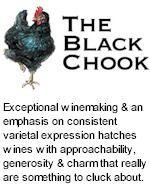
|
Woop Woop is Australian slang for the middle of nowhere in the Outback... just been to Woop Woop and back
The Galvanized Wine Group are a collective of people with passion and brands with presence, a grouping which brings together Australian wines crafted at McLaren Vintners by the talented winemaker, Ben Riggs, with owners, managers, staff and stakeholders in common. Woop Woop is a collaboration between intrepid winemaker Ben Riggs and vigneron Tony Parkinson, proprietor of runaway success Penny's Hill. The range includes wines under Mr Riggs own label label - "making the wines I love" - from the Riggs family's Piebald Gully Vineyard and only from other plots considered to be outstanding. Penny's Hill, proudly Australian, more so McLaren Vale from its own high performance McLaren Valley Vineyards.
|


|
Woodstock's founder, Doug Collett A.M. discovered a taste for wine whilst serving as a pilot for the Royal Australian Air Force, and the Royal Air Force in North Africa, Syria, Palestine and Italy
As a reconnaissance and fighter pilot in Spitfires, Hurricanes and lighter aircraft, Doug observed the vast vineyards of Europe and developed an interest in wine. After studying Oenology at Roseworthy Agricultural College after the war, Doug soon took charge of Australia's biggest winery at Berri in South Australia's Riverland. Doug developed a special regard for the McLaren Vale region, its climate, natural beauty, its full-bodied wines and their rich middle palate flavour.
|


|
The Wolf Blass winery is located at the epicentre of the Australian wine industry, the Barossa Valley and has produced some of Australia's finest wines since 1966
Wolf Blass Wines International was born in 1973 when Wolf started his own business, purchasing a 2.5 acre land holding with an old army shed outside Nuriootpa, at the northern end of the Barossa Valley. John Glaetzer joined the company and from 1974-1976 Wolf Blass Wines won three consecutive Jimmy Watson Trophies, the Black Label generated substantial publicity and hype. From this time onwards growth was impressive with Wolf Blass Yellow Label and Riesling becoming Australia's top selling red and white wine.
|


|
The Wirra Wirra Cellars were built by Robert Strangways Wigley, one of the McLaren Vale's all time characters
Wigley began building at the turn of the century using Dr. A.C. Kelly's plans of a split-level design that his friend Alec Johnston had used to build the Pirramimma winery. Wirra Wirra is an aboriginal name meaning amongst the gums. Born in 1864, Bob Wigley studied Law and Architecture and managed to play cricket for South Australia. His wild pranks as a young man had already made him somewhat of an embarrassment to his family. In 1893 he was prudently sent to rusticate in McLaren Vale. He planted the vineyard in 1894 and made his first wine with Alec Johnston in 1897. By 1901 he was the owner of one of the best wineries and vineyards in the district with 100 acres under vines and 15 acres under currants.
|


|
The Wilson Vineyard is a small family winery in the Polish Hill River sub-region of South Australia's Clare Valley
In 1973, John Wilson set out with soil map and sampling auger in search for the plot for his vines. The chosen land was some of the grazing slopes east of Sevenhill. The locals were bemused by this venture and were firm but kind with their advice about the unsuitability of the area for grapes. To that same handful of locals the little valley was known as Polish Hill River, a quaint tribute to its early pioneers. In 1980 the vineyard produced its first commercial wine and with that Shiraz-Cabernet, wine consumers were introduced to this hitherto unknown corner of Clare. By then no-one had any doubts about the ability of Polish Hill River to produce fine wine. The Wilson family has been content to expand its operation slowly and steadily and is unfussed that most who followed them now cultivate larger tracts.
|


|
Whodunnit
|


|
Inspired by an intense passion for the land, Unico Zelo wines are crafted to showcase the unique sites and soils which Australia and the Adelaide Hills can offer
Being winemakers, Unico Zelo are people who are incredibly passionate about the soil and produce in Australia. It's their contention to showcase products to the rest of the world that embrace Australian native ingredients and pay homage to the custodianship of the indigenous people who maintained the land for thousands of years. Great wines made in styles that are typified by the life and culture of this sunburnt country, from grape varieties that require minimal intervention. It's this passion that has driven Unico Zelo to start two wine labels, one that protects farmers and another that protects the future. They've since taken these concepts, alongside their Applewood Distillery, and catapulted them into the horticultural realm, studying indigenous produce, it's beneficial effects on the land and the stories it can tell through incredible colours, flavours and textures.
|


|
The story of Tyrrell's Wines is inextricably linked to the story of wine in Australia
It is a story about pioneers, men and women who transformed the Hunter Valley of NSW, planted grapes there, and looked for better ways to make wine. English immigrant Edward Tyrrell planted his first vines in the Hunter Valley in 1858 establishing Tyrrell's Wines after receiving a land grant in apparently poor pastureland in the lee of the Hunter Valley's Brokenback range.
|

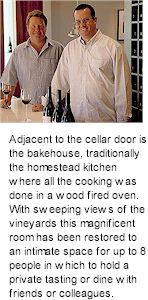
|
The 'two hands' are Michael Twelftree and Richard Mintz who formed the company in 1999 with the clear objective of making the best possible Shiraz
Michael came to the wine industry from a construction background having spent years attending wine tastings and collecting the wines of the world. In 1998, he established his own Australian wine export company and after three successful years of selling other people's wine, he and business partner Richard Mintz decided to start their own operation.
|


|
Tim Gramp is fifth generation of the family which made Orlando Wines famous
Tim has continued the tradition under his very own label, his estate wineworks are fortuitously based in the Clare Valley, home to some of Australiaâs finest vineyards. Nestled in the hamlet of Leasingham, 2 kilometres south of Watervale, the Tim Gramp winery has served as a production and cellar door since 1996. The four acre Cabernet Sauvignon vineyard, winery complex and old stone cottage provided the perfect opportunity for Tim Gramp to pursue his winemaking direction and philosophy. Since 1996, many developments have taken place at Gramp headquarters. These include extensive renovations to the old cottage, a total refit to the winery, a new crushing facility and crusher/ destemmer, housing of an old basket press and the planting of a new Cabernet Sauvignon vineyard, designed using a unique Italian Sylvoz trellising system, the first of its kind in Clare Valley.
|


|
The Tim Adams winery is located 130 kilometres north of Adelaide in South Australiaâs beautiful Clare Valley
Tim Adams began work in the wine industry as a cellarhand at the Stanley Wine Company in February 1975. He progressed to the position of laboratory assistant in 1976, and with encouragement and financial assistance from Mr Mick Knappstein, the then General Manager, Tim enrolled in the Bachelor of Applied Science (Wine Science) at Charles Sturt University in Wagga Wagga, NSW, and began studying by correspondence.
|


|
Best known as an inspirational leader of the contemporary Grenache movement, Thistledown make small batch wines from the fruit of wonderful South Australian vineyards
It's no secret that Thistledown are obsessed with Grenache, particularly the old vine, dry grown stuff of Barossa and McLaren Vale. Maybe it's the result of years travelling around the vineyards of Spain. Grenache, in all its guises, flows through the veins of Thistledown's devoted team. They have begun assembling a collection of some of the best Grenache vineyards, with the intention of becoming the authority on Australian Grenache. Thistledown's approach to winemaking is simple. They work with remarkable sites, so the job is simply to capture and coax the extraordinary richness of that fruit into bottle, retaining as much of the personality and vitality as possible. Low yielding sites, hand picked a little earlier into the vintage, yielding vines of outstanding power and singular excellence.
|


|
Situated at the very heart of South Australiaâs beautiful Clare Valley, Taylors has become one of Australiaâs best loved and most trusted wineries
The tale of Taylors winemaking goes back a few years â three generations in fact, and all began with Bill Taylor Senior, and his love of a certain Bordeaux wine. Originally wine merchants in Sydney, a passion for wine was all part of being a Taylor, and in particular, for the famous French Clarets such as Chateau Mouton Rothschild in Bordeauxâs Medoc region. It was this long held fascination for these wines which inspired the familyâs foray into winemaking, and provides the inspiration and winemaking philosophy behind all Taylors winemaking today â to produce premium wines of exceptional and comparable quality in Australia.
|

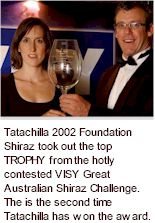
|
Tatachilla has been part of McLaren Vale since vines were first planted in 1887
The cooler regions of McLaren Vale produce highly aromatic fruit. Throughout it's rich and colourful history, Tatachilla has intuitively understood the potential of this maritime area with its rich soils and cooling sea breezes. McLaren Vale's climate is defined by the region's proximity to the sea and is distinctly Meditteranean. The vines of Tatachilla bask in sunlight, and are gently cooled by late afternoon sea breezes off the Gulf of St Vincent, and the gully winds rolling down the lower ranges.
|


|
Situated right in the heart of the McLaren Vale, Tapestry's rich ironstone soils and cool coastal climate provide ideal conditions for producing well structured and richly flavoured wines of exceptional quality
Surrounded by undulating hills and with the waters of the Gulf of St Vincent sparkling in the distance, the view from Tapestry Wines is both relaxing and therapeutic the perfect environment for the discerning wine drinker or your next special function. Estate grown vines are the major source of fruit. The vines span two vineyards within the McLaren Vale Wine Region. Both vineyards are very low yielding and produce fruit and wines with intense flavour and concentration. Tapestry's commitment to quality has seen this relatively small boutique label receive a number of awards and go on to establish export markets everywhere.
|


|
The Tait family have been coopering the finest wine barrels for over a century, today they are one of the Barossa's premiere winemaking estates
The genesis behind Tait Wines was Giovanni Tait (1927-1997). Giovanni learned cooperage from his father and grandfather before migrating to Australia from Italy in 1957. He took up work as a cooper in the Barossa. His skill and craftsmanship at his chosen trade led him to B Seppelts and Sons where he took an active role in the vinification and maturation of wine in the finest oak casks.
|

|
Stephen John
|

|
We wanted to do something that had been done before, to make exceptional wine with small estate charm
We blame the booze. The whiff and the swill did us in and all that was left to do was to make more. In many ways the wines that werenât worth the pull on the cork caused this as much as the wines that we will never have the pleasure of decorking again.
|


|
Welcome to Skillogalee - a boutique family-owned and operated winery located in the heart of the picturesque Clare Valley in South Australia
Skillogalee sits quite small compared to many winemaking operations, at a mere sixty hectares. Within the Clare Valley, it occupies the western extreme of the Sevenhill sub-region and is bounded on the western side by the Spring Gully Conservation Park, home of the rare Red Stringy Bark gum tree. It is around 8km south of Clare township and about 135km due north of Adelaide.
|


|
Shingleback is a family-owned wine estate handcrafting rich, fruit-forward Shiraz, Cabernet Sauvignon, Chardonnay, Rosé and Grenache from the McLaren Vale
The Shingleback winemakers utilize innovative canopy management and progressive farming techniques to produce wines of exceptional quality and character. Shingleback Wine takes its name from one of South Australia's most loveable lizards, the Shingleback, typically found in backyard gardens including those of Shingleback owners John and Kym Davey.
|


|
The Jesuits Society of Jesus migrated to Australia from Austria in 1848 seeking a life free from religious and political persecution
They settled at a site called Open Ranges in the beautiful Clare Valley and established Sevenhill, the oldest existing winery in the Clare Valley. Initially the main purpose of the cellars was to provide sacramental wine for religious use and this has been ongoing. Sevenhill Cellars now produce white, red and fortified wines as well as sacramental wine.
|


|
Serafino Maglieri arrived in McLaren Vale 1968, partnered with his father who was working at Pirramimma and founded one of the McLaren Vale's leading wineries
From picking, pruning and cellar hand work to planting his own vineyards and building his first winery, Steve has enjoyed great success. In 1965, the father and son team bought 40 hectares of McLaren Vale scrub and set about the task of clearing it and planting vines. In 1972 Steve started his own winery Gully Wines, which he renamed Maglieri Wines in 1977. Steve wanted to create distinctive and characterful McLaren Vale wines and established his own style. The quality of wines improved steadily and by the early 1990s Maglieri was well positioned at the top of the McLaren Vale ladder. One of Serafinoâs greatest achievements has been sensational success at the International Wine Challenge in London. Twice the Maglieri Shiraz beat all comers and was voted Best Shiraz of the Competition.
|


|
Scotchmans Hill is a family owned vineyard and winery based on the Bellarine Peninsula in Victoria, Australia
Established in 1982, Scotchmans Hill has become a producer of some of Australia's most complex, elegant and consistent wines. Scotchmans Hill is located on Mount Bellarine which was named by the Scottish immigrants who settled the Mount Bellarine area in the 1840s. Mount Bellarine was formed over 30 million years ago by tectonic movement which formed Port Phillip Bay and the surrounding volcanic region of Geelong and Mount Bellarine.
|


|
Domenico Scarpantoni immigrated to Australia in 1952, travelling and working around the country before settling in with Thomas Hardy and Sons at Tintara in the McLaren Vale
McLaren Vale is a picturesque country town approximately 45 km south of Adelaide, South Australia. With its vineyards sprawling over hundreds of undulating kilometres, it is the toast of South Australia's world-renowned Fleurieu Peninsular.
|


|
Stephen Pannell is one of the nation's most decorated winemakers, he makes wine that's designed to accompany the Australian way of life, wines that drink well alongside the opulent menu of ingredients and cuisines which are
on offer in the land downun
SC Pannell is a small, family owned and operated winery, established 2004 by Stephen Pannell and wife Fiona Lindquist. The winery was founded to focus on Stephen's passion for McLaren Vale and its ability to produce dry grown, environmentally sustainable Shiraz and Grenache. In his capacity as Chief Red Wine Maker at BRL Hardy, Pannell gained an intimate knowledge of the regions vineyards and sub-regional variations, he was able to secure exquisite parcels of old vine Grenache and Shiraz from low yielding, dry grown sites. He wanted to make wines from the region that express their sense of place and define the character and expression of McLaren Vale.
|


|
In a little over 30 years, Rosemount Estate has established itself as one of Australia's most dedicated, innovative and leading wineries
Much has changed over the years at Rosemount Estate however, the commitment to quality that defined the original vision for Rosemount Estate's humble beginnings in the Hunter Valley has remained intact. This vision has remained pivotal to the progress and success of the now world famous winery that is Rosemount Estate.
|


|
RockBare was born out of Tim Burvill's desire to create his own wine from fruit grown to Australia's best viticultural regions
Growing up in Western Australia, Tim's interest in wine was sparked at a young age by frequent summer holidays to the Margaret River region. He fell in love with the world of wine, his passion eventually saw him move to South Australia, where he completed an honours degree at Adelaide University's Roseworthy Campus. His first job was with Southcorp, which as Tim puts it "was the best start to a winemaking career that anyone could ask for." For the next 5 years Tim worked with Southcorp, travelling the country plying his craft in the Coonawarra (Wynns) and the Barossa Valley (Penfolds), the Sunraysia and the Riverland, refining his style alongside some of the best winemakers in the country. A rapid rise through the ranks soon saw him vested with the responsibility at the age of 25, of making Southcorp's ultra-premium white wines, including Penfolds Yattarna. In 2001, Tim decided to follow his own path and began RockBare, focusing on Chardonnay and Shiraz from South Australia's McLaren Vale.
|


|
In 1856 an Irish cobler by the name of Hugh Reilly arrived at the tiny township of Mintaro in the Clare Valley
Over the next 10 years, Hugh converted the stone barn that had been his home into a cottage. Reilly's Cottage served as the local Cobbler's Shop in the centre of the bustling town, which had boomed with the discovery of slate in the area. Almost 140 years later, the cottage has been restored to its former glory by distant relatives of Hugh, the Ardill family, and once again it is a hive of activity, and home to Reilly's Wines.
|


|
Primo Grilli planted his vineyard in 1973 a a spot 30 kilometres north of Adelaide within the rich fertile market gardening land of Virginia
Only 3 kilometres from the coast, Virginia enjoys the benefits of the cool sea breezes that sweep over the plains in the evenings. Primo built his vineyard with passion and understood completely the life of a vine. The grapes were grown to be turned into wine. His eldest son Joseph grew up with the vines tending them with the rest of the family. Joseph was to be a winemaker. It was not a conscious choice, not an expectation, just a progression, what he had to be. From his very first vintage, at age 20, Primo Estate's Joe Grilli wanted to create revolutionary wines. Ever since, Joe has been doing exactly that; creating some wonderfully dazzling and unconventional wines under the Joseph and Primo Estate labels.
|

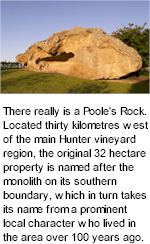
|
Pooleâs Rock Vineyard was founded 1988 in the Broke Fordwich district of Hunter Valley by McQuarie banker David Clarke
Located thirty kilometres west of the main Hunter vineyard region, the original 32 hectare property is named after the monolith on its southern boundary, which in turn takes its name from a prominent local character who lived in the area over 100 years ago. Four prime hectares were planted solely to chardonnay vines, an endeavour described by legendary Australian winemaker, Murray Tyrrell, as the viticultural showpiece of Hunter Valley. David Clarke spent two years in search of this ideal site, one that would provide a suitable microclimate and alluvial soils conducive to the production of premium chardonnay. He engaged viticultural consultant Di Davidson to assist with the vineyardâs design. Development and planting commenced in spring 1988. They took meticulous care in establishing the vineyard, which is fully irrigated. The vines are now fully mature and producing remarkable quality fruit.
|


|
Pirramimma was founded by Alexander Campbell Johnston in 1892 and has been owned and operated by the Johnston family ever since
The Johnston family arrived in South Australia in 1839 and in 1892 Alexander, the tenth of thirteen children, purchased 97 hectares of rich farmland southeast of the then fledgling village of McLaren Vale. He named his land Pirramimma, an Aboriginal phrase meaning 'the moon and the stars'
|

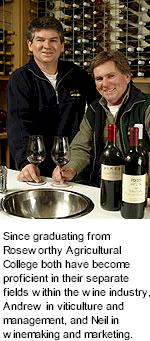
|
Englishman Henry Pike immigrated to South Australia in 1878 aboard the HMS Oakland
Henry Pike settled in the small town of Oakbank in the Adelaide Hills and in 1886 established the family brewing business called H. Pike & Co. The name became well known throughout South Australia for its quality beer, soft drink and tonic ale, and the company used the English Pike fish on the label, which remains to this day - a symbol of Pikes' long heritage. The sale of H. Pike & Co. in 1972 did not end the family tradition. Henry Pike's great grandson Edgar was well established in the wine industry as a private vigneron and as a vineyard manager for a large proprietary wine company. His sons, Andrew and Neil, have both followed in their father's footsteps.
|


|
Egerton E.S Dennis settled on ninety acres of vineyard at McLaren Flat after serving in the RAAF
Ege pioneered the production of Mead and sold his crop of wine grapes to some of Australia's most eminent brands before founding his own label in 1971, with the object of converting the high quality fruit into pure, estate made wines. Since establishment, Dennis Wines have collected over 200 medals at national and international wine shows, twice claiming the revered Bushing King awards for best wine at the McLaren Vale Winemakers Exhibition. The tradition continues of producing vintages of the finest quality McLaren Vale wine.
|


|
Established by Brian Croser in 1976, Petaluma is one of Australia's most prominent wine companies.
The pre-eminent quality of Petaluma's wines is based on distinguished vineyard sites for each of the chosen varieties, in four important South Australian wine regions - Piccadilly Valley in the Adelaide Hills, for Pinot Noir and Chardonnay - Mount Barker in the Adelaide Hills, for the Rhone varieties Viognier and Shiraz - Clare Valley, for Riesling and - Coonawarra, for Cabernet Sauvignon and Merlot
|


|
The vineyards around the foothills behind McLaren Vale have always produced some of the regions finest wines, the enriched soils and sea breezes off St Vincentâs Gulf, set the scene for high quality wine grapes
In 1981 the Australian Wine Industry was in bad shape. Classic old vines, used to make fortified and red wines, were being removed. Big companies were pulling out of the industry. Twenty four year old Geoff Hardy had recently graduated from Roseworthy Agricultural College and had seen how the Californians were grafting old vines over to new varieties such as Chardonnay. Geoff formed a partnership with Ian Leask who already had a solid history in viticulture and was then managing the Ryecroft Vineyards. The vineyard was available for sale and this is how Pertaringa, an Aboriginal name meaning Belonging to the Hills, was born.
|


|
Pepperjack wines are an endowment, from the noble House of Saltram, to all the good red wine enthusiasts of Australia. Originally created and crafted by the nation's most eminent father and son winemaking teams, Jimmy Watson winning winemakers Bryan and N
The Dolan name is an icon of Barossa winemaking. Nigel Dolan is the current Chief Winemaker at Saltram wines, a position also held by his father Brian Dolan from 1954 to 1959. Nigel, who is also responsible for the irrepressible Metala, enjoys an outstanding reputation as one of Australia's finest winemakers. Nigel has won numerous accolades in his career, three times winner of the coveted Stodart Trophy, and most notably as a dual winner of Australiaâs most prestigious prize, the Jimmy Watson Trophy in 1992, and most recently in 2003 for the 2002 The Eighth Maker Shiraz.
|


|
Penny's Hill is are renowned for their distinctive red dot packaging and overwhelming critical acclaim ever since the inaugural 1995 vintage
Penny's Hill remain committed to producing the very finest fruit from their superlative estate vineyards, the superior Penny's Hill site, Goss Corner and Malpas Road properties. Penny's Hill are housed at Ingleburne, originally owned by Thomas Overton who farmed the land and established a Dernier school on the property in 1848. Ingleburne was established by Thomas Goss who leased and later purchased the property in 1854. Goss had the good fortune to return from the Victorian goldfields some fifteen hundred pounds for the better. No doubt this enabled him to build the double storied residence, so long a landmark on the way south from McLaren Vale to Willunga.
|


|
Penfolds was founded by a young English doctor who migrated to one of his country's most distant colonies a century and a half ago
Dr Christopher Rawson Penfold was born in 1811, the youngest of 11 children. He studied medicine at St Bartholomew's Hospital, London, graduating in 1838. Like many doctors before and since, Dr Penfold had a firm belief in the medicinal value of wine. Before he left Britain he had obtained vine cuttings from the south of France and these were planted around the site of the modest stone cottage he built with his wife, Mary, at Magill on the outskirts of Adelaide in 1845. The couple called this house The Grange, after Mary's home in England.
|


|
Paxton Vineyards Pty Ltd is one of South Australia's leading producers of quality fruit for the wine industry
David Paxton has been growing grapes in McLaren Vale for almost 30 years. In this time he has developed and managed vineyards in the Adelaide Hills, Coonawarra, Yarra Valley, regions of Western Australia and has consulted to growers across the country. David's company Paxton Vineyards owns approximately 200 acres of premium McLaren Vale vineyards and manages over 500 acres in the region as well as over 25 on Kangaroo Island. Whilst the majority of the grapes grown by Paxton are sold to wine companies, a small portion is utilised for the Paxton label.
|


|
About 1½ hours drive north from Adelaide is the beautiful Polish Hill River sub-region of the Clare Valley, home to Neil and Alison Paulett and their winery
The Polish Hill River region was named after the Polish Settlers of the mid 1800's. The area is blessed with a climate ideal for premium grape growing and the combination of consistently good winter rains, hot summers tempered by cool nights and a long ripening period produces grapes of exceptional flavours and balance.
|


|
Partisan take aim with each vintage at crafting a range of wines which are fundamentally endowed with maximum varietal character and discernible McLaren Vale charm
The Partisan range embraces and illustrates the sub regional characters within McLaren Vale from the regions most suitable grape varieties, Shiraz and Grenache, Mourvedre and Tempranillo. Partisan are all about people of the soil, nurturing and caring for the land, taking up McLaren Vale viticulture at a time in history when others were pulling out their vines and devolving into other forms of agriculture. Focused on producing affordable wines that are fully expressive of provenance and variety, Partisan hand select parcels of fruit parcels which are most suitable to microclime, sub region and terroir.
|


|
In 1839 William and Elizabeth Oliver travelled to South Australia from Berwick in Roxburghshire, Scotland eventually settling on land at McLaren Vale
Whitehill and Taranga farms, the names given to the northern and southern sections of this land, are located 2 km north of McLaren Vale overlooking the township. Taranga is a corruption of the aboriginal word Tarangk, meaning the middle which was used by the Kaurna, a local aboriginal tribe. Sheep and cattle were raised and orchards and vineyards were planted immediately upon arrival and the family prospered. William and Elizabeth are buried in a marble crypt, with three of their ten children beside them, in the family cemetery on the northern edge of the Taranga property.
|


|
O'Leary Walker Wines is the culmination of two like minded winemakers that met over twenty years ago
Established in 2001 by David O'Leary and Nick Walker, their philosophy is pretty simple, source the best grapes from the best vineyard sites and craft great wine. O'Leary Walker is based at Leasingham in the Clare Valley, South Australia, but they don't limit themselves to producing just Clare Valley wines. O'Leary Walker also source fruit from other premium grape growing districts in South Australia including the Adelaide Hills, Barossa Valley, Coonawarra and McLaren Vale. The theory behind this is to draw on the grape varieties that excel in these quite different viticultural climates.
|


|
Nugan Estate is a story of inspiration about a premium producer of estate grown wine based in Griffith New South Wales
The Nugan Group was founded in 1940 when a young Alfredo Nugan emigrated from Spain with his family to start a small fruit and vegetable packing operation in Griffith, New South Wales. Nugan's daughter in-law Michelle became responsible for the Groupâs renaissance into one of Australiaâs most successful agricultural enterprises. Looking beyond Australiaâs shores, Nugan became the largest exporter of niche juice products to Asia in the Southern Hemisphere with production in excess of 70,000 tonne per annum.
|


|
And, yes.. Ben does have a vineyard
Located at Kangarilla on the edge of the McLaren Vale designated region, Piebald Gully is a recently planted patch producing fine grade Shiraz, Viognier and Petit Verdot from low yielding hand tended vines. Besides 22 vintages in Australia, Ben has presided over a further eight overseas. Experience has been gained in the Napa Valley, Bordeaux, Greece, Italy and the South of France which gives Ben a broad appreciation of wine styles and winemaking practices. A graduate of Roseworthy (in 1985), Ben has made a major contribution to regional wine industry activities having served 10 years as a board member of McLaren Vale Winemakers Inc. Three of those years saw Ben in the role of Chairman. He also chaired the McLaren Vale Wine Show over a 5-year period. Wines made by Ben have achieved considerable Wine Show Awards success including winning the first two Great Australian Shiraz Challenges. More than 20 trophies have been won and in 1993, Wirra Wirra 1991 Angelus was declared the winner of the Sydney International Top 100 wine awards.
|


|
Mount Horrocks Wines is operated by proprietor and winemaker Stephanie Toole, who restricts production to approximately 4,500 cases per annum to achieve her aims of quality and single vineyard expression
Mount Horrocks Wines was established in 1982, was acquired by Stephanie Toole in 1993, and in April 1998 opened a cellar door in the renovated Auburn Railway station, around the corner from Grosset, her husbandâs winery, where she makes her wines. Substantial renovations and landscaping of the station and surrounding railway yards have resulted in a showpiece for Auburn and the Clare Valley. Stephanie carefully crafts her wines, which she describes as "essentially hand made food wines with emphasis on structure as well as generous fruit flavours" All grapes are hand picked, and only the finest French oak is used for those wines spending time in barrel.
|

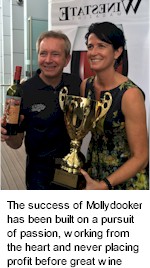
|
The success of Mollydooker has been built on a pursuit of passion, working from the heart and never placing profit before the sanctity of great wine
Sparky Marquis was a successful professional photographer when dad lined up his five kids and told them that if any of them were prepared to learn winemaking or viticulture they would inherit his award winning vineyard and winery. The Langtons listed Fox Creek. Sparky remembered how much he liked drinking wine and stepped forward. Sparky and lovely young wife Sarah went to work, built a new winery and introduced their Vineyard Watering Programme, achieving exceptional quality fruit, devoting long hours to perfecting their winemaking.
|

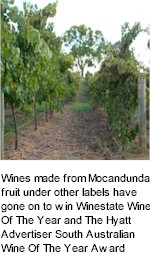
|
Mocandunda is a Ngadjuri word meaning rocky outcrop on top of a hill
Itâs on one such rocky hill that three men with Clare Valley dirt in their veins, established a vineyard that brings all their experience and local knowledge into a singular, crystal clear vision. Mocandunda was established 1998 by Hartley Heinrich, the propertyâs owner, Rodger Ackland, one of Clareâs most experienced viticulturalists and founder of Mt Horrocks Wines and Mick Faulkner, a leading South Australian agronomist. Rodger had long recognised the potential of the site and had been share farming the land with Hartley, with help from Mick, when all three men decide it was time to take this special place to the next level. And so Mocandunda Vineyards was born, a project with impeccable local pedigree and enormous potential.
|


|
It was the vision of Frank and Simone Mitolo to create individual and handcrafted wines, made with passion and an uncompromising commitment to quality
Frankâs Italian heritage provided him with an early introduction to wine appreciation and winemaking, while his roots are rich in horticultural history spanning three generations. With the active involvement and support of his wife Simone and their children Gemma, Alexander and Marco being their inspiration, their first wine G.A.M., a 2000 McLaren Vale Shiraz was produced.
|


|
Jane and Andrew Mitchell established the winery in 1975 on the Mitchell family property in the western hills of the Clare Valley in South Australia
An old sandstone apple store was converted to serve as a rustic cellar door sales area. Continued growth has resulted in further development of the winery buildings and winemaking plant. Currently the prize harvests of premium fruit is crushed and processed in a well equipped modern winery. The imposing two-storey century-old family home sits amid the vineyards, overlooking the winery.
|


|
Since 1979, family owned Maxwell Wines, with its forty acre estate vineyard, has built a reputation for handcrafting superior and world class wines that combine exquisite fruit quality with structure and finesse
The Maxwell family is also famous for its range of Maxwell Meads, being the most significant producer in the southern hemisphere of this time-honoured, delicious and golden fermented honey. As mead is one of the oldest fermented drinks known to mankind, the late Ken Maxwell was inspired to research and produce what are now highly acclaimed as the benchmark of meads in the world. The Maxwell Meadsâ purity of flavour is testament to 50 years of family research and development.
|

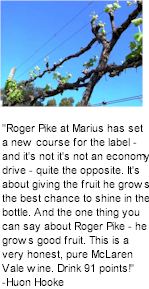
|
Marius Wines is a small premium wine producer in McLaren Vale
There is now a small, but growing, number of wine consumers who recognise Marius Wines as a best value producer of premium McLaren Vale Shiraz.
|

|
The Lynn family have been residents of the Penola - Coonawarra district for over four generations, starting out as Store-Keepers and then graduating into grazing
The property on which Majella now stands was originally owned by Frank Lynn, and bought by his nephew, George, in 1960. George and Pat Lynn kept Merinos for wool production on their farm about ten miles away, and had always wanted some good Coonawarra country for their up-and-coming prime lamb enterprise. Viticulture, however, was not on their agenda until 1968.
|


|
Giovanni Maglieri arrived in McLaren Vale in 1958 and worked in the vineyards of Pirramimma Wines
Five years later, Giovanniâs 17-year-old son, Steve, arrived in Australia. Then, in 1965, the pair bought 40 hectares of McLaren Vale scrub and set about the task of clearing it and planting vines. In 1972 Steve started his own winery Gully Wines, which he renamed Maglieri Wines in 1977.
|


|
Over the past seventy years a number of memorable wines have been released under the Leo Buring name. In 2002 the winery returned to its roots, making only Riesling
Among the many personalities that have shaped the Australian wine industry over the past 150 years one name stands pre-eminent, Leo Buring. Hermann Paul Leopold Buring was born in South Australia on the 7th October 1876, the son of German immigrants. He was a highly skilled winemaker and is often described as Australia's Ambassador for Wine because he was one of the first to export Australian wine to many countries as far back as the early 1900s.
|


|
Leconfield was established in 1974 by noted Oenologist, Sydney Hamilton
At the fine age of seventy six, after a winemaking career spanning nearly 60 years with the family company in Adelaide, Sydney still yearned to make a classic Australian Cabernet Sauvignon and set himself the task of finding the right district in which to establish his own vineyard and winery. Showing great foresight, Sydney selected Coonawarra as the area with the potential to fulfil his ambitious dream. Thus Leconfield was born, named after an English ancestor, Lord Leconfield.
|


|
The Clare Valley, set in the folds of the Mount Lofty Ranges 140 kilometres north of Adelaide is proud of it's long history of outstanding winemaking
At around 400 metres elevation the Clare Valley is characterised by cool night time temperatures and warm days. In 1893 a group of South Australian entrepreneurs founded The Stanley Wine Company to produce high quality Clare Valley red and white wines. Subsequent generations of wine drinkers and wine judges have applauded their decision and confirmed their hopes.
|


|
Leabrook Estate is a family-owned boutique winery located in the cool climate Adelaide Hills at Lobethal in South Australia
Leabrook Estate specialises in high quality Pinot Noir and Chardonnay and produces wines from a range of other cool climate varieties including Sauvignon Blanc, Cabernet Sauvignon, Cabernet Franc and Merlot. The story of Leabrook Estate started in 1978 around bottles of Burgundian wines at dinner parties. The wines had great character and delicacy. This was the beginning of Leabrook estate founder Colin Best's love affair with Burgundy and things Burgundian. These wines had an extra dimension of elegance and intensity.
|


|
Koltz began as a small wine label in 1995 when winemaker Mark Day and Anna Koltunow made their first wine using grapes from the Bottin Vineyard in McLaren Vale
Since that time Koltz has evolved and now specialises in Shiraz and Shiraz blends from the McLaren Vale region, renowned for its Shiraz wines worldwide. Mark Day has worked as a wine maker for Maxwell Wines and Wirra Wirra in McLaren Vale and as a consultant in Italy and France over the last 6 European vintages.
|


|
Knappstein is one of the most recognisable and popular Clare Valley wineries
Knappstein are a small producer of premium quality wines, who manage their own vineyards. Redeveloped around the historic Enterprise Brewery building at the heart of Clare township, and deeply connected to the community and cultural life of Clare. The Knappstein name has been involved in the wine business in Clare since 1895. The winery was originally founded by Tim Knappstein as Enterprise Wines, a name utilised for the premium Cabernet Sauvignon vineyard and thus honouring the Knappstein heritage as early winemakers connected with Clare for well over 100 years.
|


|
Kirrihill Wines was established in 1999 and is located in the gently rolling hills of South Australia's famous Clare Valley wine region
Kirrihill Wines was created on a passion for fine wine and a desire to produce super premium wines equal to any. "We source fruit for our two ranges, Kirrihill Estates and Kirrihill Companions from some of Australia's most recognised wine regions, the Clare Valley, the Adelaide Hills and Langhorne Creek. This provides our wine making team led by David Mavor with a diversity of fruit supply, enabling the production of an exceptional array of premium wines equal to any in the world.
|


|
Kingston Estate Wines has grown rapidly since Sarantos and Constantina Moularadellis first developed their 40 acre vineyard in 1979 in South Australia's Riverland wine region. Today, Kingston is the 10th largest wine producer in Australia and remains one
Their son, managing director and chief winemaker, Bill Moularadellis, joined the family business in 1985 as a young Oenology graduate from Roseworthy College with a vision to produce premium wines from the Riverland. His first crush in 1986 produced 60 tonnes (principally reds) and in that year the first commercial vintage of 4,500 cases of wine was produced.
|


|
Kevin Mitchell's tireless and passionate devotion to his chosen craft has propelled him to international cult status
Like many Australian winemakers Kevin Mitchell is highly trained in both the scientific and artistic sides of winemaking. He also comes from a long tradition of grape growing in the Clare Valley. Kevin began a prolific winemaking career in 1993 as cellar hand. He worked his way up within the industry to be assistant winemaker at a list of companies including Krondorf, d'Arenberg, Kingston Estate, Orlando and BRL Hardy, as well as wineries in the USA. Mitchell purchased the Kilikanoon property in the heart of the picturesque Clare Valley in 1997 with a vision of creating his own brand. The first Kilikanoon releases in 1998 met with immediate export success, and the international reputation for this sensational Clare winery's editions have built steadily from there.
|

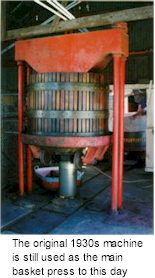
|
Bordering St. Vincents Gulf, 40 kms south of Adelaide, Amery Vineyards grace the rolling foothills of the Southern Mt. Lofty Ranges
In the early 1850's Richard Baker Aldersey bought several sections of land 6 kms north of McLaren Vale in a hilly area near Hope Farm (Seaview). He built a fine ironstone house and named the property Amery, after his birthplace Amery Farm near Alton, in Hampshire, England. The land was partly cleared until Amery was acquired by William Hammond junior, whose father owned the adjacent Hambledon Farm where he settled after quitting his sugar plantation in Jamaica. In 1886 young William Hammond planted out the original seven acres of vineyard at Amery, but for the main part he ran the 339 acre property as a farm, raising cattle and sheep, cereal crops, soft fruits and vegetables. In 1890 the Amery property was bought by the Kay Brothers, Herbert and Frederick, and they finally came into possession on February 2nd 1891.
|


|
Established by Helen and Kevin O'Brien in 1997, Kangarilla Road Vineyard and Winery is based in McLaren Vale South Australia
McLaren Vale is less than an hours drive from the city of Adelaide. The region is defined by some lovely beaches on the western boundary and by low lying hills to the east. McLaren Vale is the best region in Australia to achieve the wine styles that Kangarilla Road does well. The long, dry growing season can often become indian summers, translating into Shiraz, Cabernet Sauvignon and Chardonnay fruit of aromas and flavours and balanced nicely in the reds with soft approachable tannins. In addition, the Kangarilla Road winemaking team are playing around with some new varieties to the district, namely Zinfandel and Viognier and we are very excited about the quality of these wines to date.
|


|
The Jim Barry vineyards were established in the cool uplands of the North Mount Lofty ranges in 1959
In his 57 years of winemaking, the late Jim Barry saw many changes. Jim Barry graduated from Roseworthy Agricultural College in 1947 and was offered a position at the Clarevale Cooperative, becoming the first qualified winemaker to work in the Clare Valley. In 1959 Jim and his wife Nancy purchased their first property on the northern outskirts of Clare and in 1964 purchased 70 acres of land from Duncan McRae Wood, part of which now forms the famous Armagh vineyard. With a growing family to look after, Jim took on the challenge of establishing his own winery and cellar door, with the first home-made wines being produced in 1974. "When I first came to the Clare Valley, grapes were delivered by horse and cart. Today our business is international but one thing won't change, at the end of the day, the wines are what matters!"
|


|
The history of Jacob's Creek begins with the earliest settlement of South Australia
Colonel William Light, who surveyed the city of Adelaide in 1836, made his way northeast to the Barossa Valley, which he named after an English victory in the south of Spain during the recent Napoleonic Wars. Later, when William Jacob surveyed the Barossa in 1839, he and his brother John took up land in the Hundred of Moorooroo; a word derived from the aboriginal meeting of two waters The two waters involved were the North Para River and a creek, which fed into it. The creek was later named Jacobâs Creek after William Jacob. Today, the Jacob brothers small cottages still stand, overlooking Jacob's Creek.
|


|
The Ingoldby family has been associated with McLaren Vale winemaking heritage for more than a hundred years
Since inaugural release Ingoldby have enjoyed a stunning run of success at national wine shows. It was in 1973 that Jim Ingoldby finally adorned the label of traditional McLaren Vale wines with the family name. From the outset Jim and his Ingoldby wines were unashamedly proud of their McLaren Vale heritage. The region is often referred to as the middle palate of the Australian wine industry. The Ingoldby's innate skill at managing vines and soils which they have husbanded for generations yields splendid fruit with concentrated flavours. Their fruit has been the secret ingredient in many of Australia's most cherished wines. Ingoldby's Cabernet is highly valued and still sought by some of the nation's most popular brands.
|

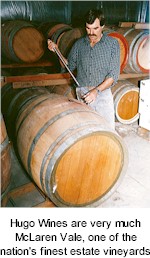
|
Hugo Wines is very much McLaren Vale, continuing the tradition of quality boutique winemaking from one of the nation's finest estate vineyards
The story of Hugo Wines is intrinsically linked to the property on which the vineyard is established. John Hugo's maternal great grandfather, George Sauerbier acquired the property and first farmed the land in the early 1900s, originally a Southdown sheep stud, grazing cattle and dairy, almonds, glasshouse tomatoes and mixed cropping, not to mention paddocks of grapevine meant for personal consumption. At that time, anything planted had to perform and provide a return, whatever the soil and climatic conditions.
|


|
Dean Hewitson is driven by passion. His creation of individual, exquisite wines from the ancient vineyards of South Australia is for your indulgence
Dean Hewitson captures the essence of history and the magic in old vines and bottles it. His passion for wine is undeniable and his desire to share this passion is even greater. This led him to a life in which he creates wine purely for the enjoyment of others. Rather than purchasing vineyards, Hewitson made the savvy business decision to create long term associations with a network of established growers, allowing him to seek out the varietals he desired.
|


|
Heirloom Vineyards were conceived in vintage 2000, when a young winemaking student caught the eye of a silly old wine judge
A love story ensued inspired by two vows, to preserve the best of tradition, the old world of wine and unique old vineyards, to champion the best clones of each variety planted in the most appropriate sites, embracing the principals of organic and biodynamic farming. Seven long vintages of trial and error passed before Heirloom Vineyards could make a wine that was fine enough to pass on to future generations. That is this wine.
|


|
Thomas Hardy left Devon in 1850 at the age of 20 and migrated to the new colony of South Australia
He established a winery on the banks of Adelaide's River Torrens in 1853. His Bankside winery was the start of an outstanding family wine business that grew to become one of the world's great wine companies. Thomas Hardy was a self-made man, a pioneer of immense character. With a mixture of energy, determination, shrewd judgment, innovation and a touch of daring, he pursued the highest standards in winemaking. At Bankside, and later at his McLaren Vale property Tintara, he focused on quality and craftsmanship. Tintara was to become the centre of Hardy's enterprise and by the late 1800s was one of the best-equipped and managed wineries in Australia. This success was substantially due to Hardy's initiatives in planting higher quality, lower yielding varieties rather than the coarser, heavier-yielding types more common at the time. His willingness to experiment with and to use novel equipment, much of which he designed and built himself, also contributed to this success.
|


|
Grosset Wines is an independently owned winery set in the Clare Valley producing just six highly regarded premium wines each vintage
Established in 1981 by Jeffrey Grosset in the historic township of Auburn in the southern tip of the Clare Valley 100 kilometres north of Adelaide, the winery is stylish but functional and reflects the attention to detail that extends to the Grosset estate-owned Clare Valley vineyards and to the winemaking.
|


|
The Geoff Merrill winemaking philosophy has been and always will be, to make wine that allows regional, varietal and vintage expression, without excessive winemaker intervention
The history of the Geoff Merrill Mount Hurtle winemaking operations begins over 100 years ago when the site was built by a young Englishman, Mostyn Owen, who purchased 200 acres of prime Reynella hillside and built a winery in 1897. Set in the Hurtle Vale Ward just behind Reynella (Hurtle Vale was named after Sir James Hurtle Fisher, the first Mayor of Adelaide). Of these 200 acres, 150 were planted with vines. Mostyn Owen ran the winery and vineyards until he passed away in the mid 1940s. Mount Hurtle was innovative for its time, using the principles of gravity to feed wine throughout the cellars. Because of this the building is now state heritage listed.
|


|
Gemtree Vineyards is owned and run by third generation grapegrowers, the Buttery Family
The Buttery family is dedicated to producing interesting and appealing wines of the highest quality from their McLaren Vale vineyards. They are also passionate about sound environmental practises, sustainable agriculture and innovation.
|


|
It all began when a group of medicos decided to realize a lifelong passion - creating a wine from bare earth and sunshine
In the past years since Fox Creek was established, many of the Fox Creek wines have been recognized by being awarded both Trophies and Gold Medals from National and Regional Wine Shows. The McLaren Vale Region has a Mediterranean style climate with a strong maritime influence and is frost-free as we are 7km from the sea. Annual Rainfall is 600-700mm falling mainly in Winter. It is an ideal location for growing grapes, with little disease pressure.
|


|
By Bill and Noel Ireland of Flinders Bay fame, Fire Block is a site that was planted predominantly to Grenache in the 1920s
Situated beside the old Watervale railway station site, Fire Block vineyard was originally planted in 1926, making the Shiraz and Grenache vines over 80 years old. The historic Fire Block vineyard was named for it's dangerous proximity to the passing railway engines of yesteryear, imperilled by the sparks of the locomotives that often started bushfires.
|


|
A bottle of good wine can help solve many problems, such were the thoughts of Norm Doole and Drew Dowie as they watched the sun rise after enduring a cold, all-night session harvesting some of their fruit from the difficult 1995 vintage
Seeing their grapes being trucked away to other wineries and frustrated at not being in control of their fruit from that point, the two opened a bottle of red wine over breakfast and decided then to form a partnership, the purpose of which was to take charge of all aspects of growing grapes, making, bottling and selling their own wine.
|

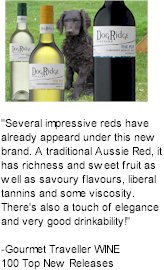
|
Dog Ridge is located at the base of The Southern Mount Lofty Ranges over looking the McLaren Vale wine region
DogRidge Vineyards employ modern viticultural practices which optimise sun exposure and canopy health, resulting in ripe fruit of intense colour and quality. This desirable combination has led to the creation of wines that express outstanding depth of colour, aromatic elegance and richness of flavour.
|


|
De Bortoli is an exciting, innovative family owned wine company, having enjoyed spectacular success throughout it's entire range of wines
The winemaking team is overseen by third generation winemaker Darren De Bortoli and his brother-in-law Steve Webber who is married to Leanne De Bortoli. The dynamic duo has been responsible for many winemaking innovations and developments. Darren De Bortoli is the creator of the world acclaimed Noble One. Steve Webber, recently awarded Gourmet Traveller WINE's 2007 Winemaker of the Year, established the Yarra Valley winery, the King Valley vineyards and oversees the Hunter Valley winery and vineyards.
|


|
The heart of McLaren Vale, past and present, dâArenberg is one of the most significant wineries in Australia
In 1912 Joseph Osborn, a teetotaller and director of Thomas Hardy and Sons, purchased the well established Milton Vineyards of 25 hectares in the hills just north of the townships of Gloucester and Bellevue, now known as McLaren Vale. Josephâs son Francis Ernest (âFrankâ) Osborn left medical school, choosing to forsake the scalpel for pruning shears. He soon increased the size of the vineyard to 78 hectares. Fruit was sold to local wineries until the construction of his own cellars was completed in 1928. Dry red table and fortified wines were produced in ever increasing quantities to supply the expanding markets of Europe.
|


|
Dandelion Vineyards really do wish you were here
Their vineyards are family, their wines are children. Serious stuff, certainly. Proper fun, absolutely. The lifelong search to appreciate and understand the essence of wine, its terroir, leads to a vinous treasure hunt, following the Dandelion's wishing clock if you will, that always inspires. Dandelion Vineyards are proven plantings that have stood the test of time.
|


|
Robert Crabtree studied law at Oxford University and was a practising lawyer/ academic at Cambridge, he always had an interest in viticulture and made fruit wines as a hobby
Crabtree's curiosity in winemaking led him to complete two vintages at Bergerac and another in New Zealand, before landing in Australia and deciding that he would become a full time winemaker. After careful selection of possible wine regions, Robert decided that the Clare Valley was to be the region of choice. Whilst studying winemaking at Roseworthy, Robert purchased a small existing property at Watervale in 1980 and named it Watervale Cellars. In 1983 Robert purchased the old Flax Mill building in Auburn. He equipped it as a small (somewhat rough and ready) winery and planted two acres of Cabernet Sauvignon. The business became known as Crabtreeâs Watervale Cellars for a number of years. Robert built an enviable reputation for fine classic Watervale wines over the following 27 years and became a passionate advocate for the Clare Valley and South Australian wine industry. Robert sold his beloved property and winery in 2007 but remains a welcome friend and advisor to the new Crabtree Crew.
|


|
Siituated in the hills north of the McLaren Vale township in an area known as the Seaview sub region, the Coriole winemaking operation was aquired and re-established by the Lloyd Family during the sixties
Coriole's old house and barn were constructed in about 1860. The slate roof of the old house, and its immense slate slab floors are typical of early houses of the district. Coriole was first owned by an English company, managed by Geoffrey Kay, a distant relative of the the Kays of nearby Amery Winery. Coriole's old shiraz vines were planted in 1919, when the district was experiencing a strong surge in export growth of its burgundy style wines to England and increasing wine sales interstate.
|


|
Cleanskin
|


|
Claymore was established in 1991 when the founding partners, who were medical practitioners, realised they could not change water into wine!
They purchased their first 11 acre vineyard at Leasingham in the Clare Valley in 1991. The terra rosa soils (red loam) on a limestone bed, support 70 year old grenache, riesling and shiraz vines. The vineyard is non-irrigated with yields low averaging 1.5 to 2 tonnes per acre. They started making a little grenache, and a little bit of riesling in quantities which the ordinary family would finish in a few months. Claymore still produce limited quantities, but over time the Claymore range has expanded to include a wide range of premium Clare varietals, filling out this boutique winery's portfolio.
|


|
Established 2008 by one of the oldest winemaking dynasties in the colony of South Australia
A Kaesler family production, alongside equitable efforts by maestros Stephen Dew and Reid Bosward. The Watervale and Polish Hill vineyards were carefully selected due to their unique soil formations and the micro climates found in the respective vineyards. The primary varietals of Riesling, Shiraz and Cabernet Sauvignon. Harvests are transported to the Kaesler wineworks in Barossa Valley for vinification. Riesling excels in Watervale and the Shiraz and Cabernet from Polish Hill represent some of the finest fruit found in the region.
|

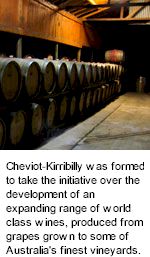
|
The launch of the Cheviot Bridge wines coincided with the new millennium and was underpinned by a desire to create wines that showcase the breadth and quality that Australia has to offer
A single minded commitment and the experience of the estate's winemaking team, many of whom have literally grown up in the wine industry, has enabled Cheviot Bridge to realize the vision. The endorsement of the passionate approach comes from the support of the customers whose loyalty has led to Cheviot Bridge becoming one of the top twenty wine companies in Australia. At Cheviot Bridge the aim is to craft wines that fit with today's varied lifestyles. So whether wine lovers are looking for something to drink everyday, a wine for that special occasion or something new and different, you will always find something to enjoy in Cheviot Bridge.
|


|
Chateau Reynella enjoys an unrivalled prestige as the birthplace of South Australia's internationally renowned wine industry and home of the state's oldest operating cellar
McLaren Vale is invariably linked to names such as John McLaren, John Reynell and Thomas Hardy. McLaren was appointed as Senior Surveyor and given the task of surveying the southern districts of Adelaide. His report on the rich and extensive valley of McLaren Vale was completed three years after proclamation in 1839. His team came across a wide valley that members of the party named McLaren's Vale. "This wide valley of McLaren gave promise of much beauty and fertility!"
|

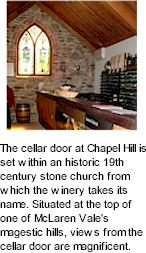
|
Chapel Hill takes its name from the historic ironstone church built at the property in 1865
Chapel Hill Winery is entirely in the Hills Face Zone. In 1990 environmental consultants were briefed to advise regarding development in this sensitive rural preserve. The estate obtained planning approval from the Minister for Environment and Planning in 1991, and built the winery in 1993. Chapel Hill is the embodiment of the wine and food experience delivered using the best of environmental practices by people who are passionate about their product and the McLaren Vale winegrowing region.
|


|
Chalk Hill is a family owned wine company dedicated to making small batch, hand crafted wines of distinction
In the heart of the McLaren Vale wine region and overlooking the township of McLaren Vale, the Chalk Hill vineyard has stunning panoramic views across grapevines to the coast. It was established in 1969 with Shiraz and Cabernet Sauvignon and more recently plantings of Sangiovese and Barbera have been added.The Harvey family grape growing heritage goes back six generations in South Australia, they now have six vineyards spread across the beautiful McLaren Vale wine region. The first family vineyard was planted in 1897 and these century old vines still bear fruit today. It is the family commitment to make wines that reveal the unique place that is McLaren Vale, and to exhibit their efforts from the vineyard to the bottle. Wine is more than just a drink, it is a reflection of place and life.
|


|
The Casella family has been making wine since 1820 in Italy, and since 1965 in Australia
Filippo and Maria Casella emigrated to Australia from Italy in the 1950s bringing with them their hopes and dreams and the know-how acquired through three generations of grape-growing and winemaking in Italy. Recognising the potential of the region, Filippo purchased a farm in the town of Yenda, New South Wales, in 1965. After selling the grapes from his farm to local wineries, he decided in 1969 that it was time for a new generation to put its winemaking skills to use, and the winery was born.
|

|
Cardinham
|
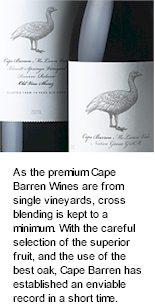
|
Cape Barren Wines create generous and profound wines, sourced from some of South Australia's finest vineyard sites
Located in the renowned McLaren Vale region of South Australia, the Cape Barren vineyards benefit from the unique maritime climate of long warm summers cooled by afternoon ocean breezes, ideal conditions for grapes destined for full-bodied red wines. Starting from humble beginnings with the first vintage in 1999, Cape Barren Wines is the result of a 35 year friendship between Peter Matthews, who has 30 years experience in executive Sales and General Management, and Brian Ledgard, a third generation grape grower, and their lifelong interest in vineyards and wine. Their ambition was and is, to produce full bodied wine of uncompromised quality and excellence.
|


|
Established in 1970, Brokenwood Wines has evolved from a weekend venture for self-professed hobby winemakers into one of Australia's most reputable wine labels
Brokenwood was founded by a trio of Sydney-based solicitors, Tony Albert, John Beeston and James Halliday, who paid a then record price of $970 per acre for a 10-acre block in the foothills of the Brokenback Ranges. The original block - originally planned as a cricket ground for the local community was planted with Cabernet Sauvignon and Shiraz.
|


|
Carol and Tony Bradley Dunn work on their own small acre vineyard and are devoted to exclusively producing the finest quality Shiraz
The philosophy at Braydun Hill is to do one thing well, and to excel at it. Experience gained at making hand made wines from fruit picked off hedgerows on the English countryside told Bradley-Dunn that Braydun Hill was the ideal grape growing site and lead to vines being planted in 1998. The vineyard is 10 beautiful acres of gentle north facing slopes on a rare patch of Paringa sandy loam over clay in the McLaren Vale, perfect for quality grape vines. The natural sloping of the Braydun Hill's terrain provides for quality ripening. The ocean breezes and maritime climate cool the summer sun and help keep the vines from the mildew and other diseases that more protected vineyards often suffer. This means that Braydun Hill's winemakers have never used any pesticides in the vineyard and have no need for artificial chemicals.
|


|
Bondar are a little winery headquarted at the iconic Rayner Vineyard, on the corner of Chalk Hill Road and Twentyeight Road in McLaren Vale
Bondar wines began its life in 2012, after a small group of family and friends hand picked a couple of tonnes of Shiraz grapes for their first ever wine. It was a beautiful, calm, warm summer's evening, and when the sun went down the McLaren Vale sky lit up with one of the most spectacularly beautiful sunsets they had ever seen. Bondar's Violet Hour Shiraz was born out of the inspiration from this magical moment. They have since won multiple trophies at the McLaren Vale Wine Shows and have been named one of the Top 50 Young Guns of Wine.
|


|
In 1997, an unassuming young viticulturalist and winemaker, Andrew Nugent, chanced his arm in the emerging wine region of the Adelaide Hills
Nugent grew up next door to Penfolds at Magill and his formative wine years were spent in South Australia's McLaren Vale. It was here that he honed his craft as a viticulturalist, vineyard manager and winemaker. In 1997, Nugent planted vineyards and an olive grove on 100 acres on Bird in Hand Road, Woodside. The road itself was named after the Bird in Hand gold mine that operated in the district in the 1850s. The Nugent family now live and work on the picturesque property, reflecting the strong sense of community in the Adelaide Hills.
|


|
Formed in 1985, Beresford Wines has established itself in 15 export markets and has received numerous prestigious show awards both nationally and internationally
Beresford wines are hand-crafted to capture the Essence of McLaren Vale. The wines offer consistent quality that epitomise the ambience and character of the McLaren Vale region. Each wine has been made with the same attention to detail that ensures the elements of richness, warmth, character, soul and depth are there for everyone to enjoy. When you open a bottle of Beresford wine you are sharing the hard work, skills, experience, creativity and passion of a dedicated team of people. This has taken Beresford Wines to where it is today.
|


|
The Bekkers story is born of a rare connection with nature, as articulated by a world of experience
One of McLaren Valeâs oldest and distinguished wineries was the setting for a chance meeting between a young French winemaker and newly graduated Australian viticulturist. Emmanuelle and Toby Bekkers have lived, worked and raised a family amongst the vineyards of McLaren Vale. For over 25 years, Emmanuelle and Toby have travelled regularly to Europe to visit an extensive network of esteemed wine makers and industry friends. After each trip they return with new inspirations and an appreciation of the traditional, timeless methods. This serves to enhance a rare and special commitment to producing McLaren Vale wines of the highest quality.
|


|
The Shaw family own and operate Ballast Stone Vineyards, they can be proud of four decades as winegrowers, vignerons and vintners
Their dream for family involvement inspired Richard and Marie to expand from 5 acres to over 1,200 acres to become one of the largest owners of vineyards in the premium cool climate regions of McLaren Vale and Currency Creek in South Australia. The Shaw family vision included producing high quality wine for the enjoyment of global wine connoisseurs. In 2000 the construction of their ultra modern, state-of-the-art winery was completed. Ballast Stone's wine is produced from grapes picked from their family vineyards and is produced at their Ballast Stone winery that is located in the Currency Creek region. Ballast Stone Estate has a range of distinguished labels comprised of Ballast Stone Estate Range, Stonemason, Steeple Jack and the ultra premium and iconic brands, Emetior & RMS.
|


|
Stephen George is one of the most naturally gifted winemakers in Australia, an early pioneer of the well established viticultural precincts on Adelaide Hills
Stephen established his 3ha dry grown Ashton Hills Vineyard in the Piccadilly Valley in the early 1980s and began producing its first wines in 1987. The style reflects the regionâs strong similarity to Burgundy and production levels have stayed true to the boutique nature of the wineryâs beginnings. The Ashton Hills Vineyard provides the fruit for the majority of Ashton Hills wines including single vineyard wines in the Reserve Pinot Noir, Estate Pinot Noir and Riesling. As custodian of the vineyard for over 30 years, Stephen has harnessed the three key climate variables (humidity, temperature and rainfall) he believes are critical to the Ashton Hills site and developed a reputation for producing some of the finest wines from the Adelaide Hills.
|


|
Aramis Vineyards, completely McLaren Vale, family owned, estate vinified and estate grown
Aramis hve been awarded a staggering amount of awards and accolades at Australian and international wine shows in recent years. The vineyards are planted on their own rootstock to some of the worldâs oldest mineral rich soils and in the most temperate of Mediterranean climates. The vines consistently produces excellent fruit quality from low yielding vines. Only the best parcels of fruit are carefully selected from the vineyard and bottled under the Aramis label. Great attention to detail with the integration of fruit flavours and fine oak barrels helps produce classic handcrafted styles of wine. Aramis have pursued their passion to produce rich and intensely flavoured wines. There are 64 acres planted, the majority of which is dedicated to Shiraz and Cabernet Sauvignon. Knowledge of the vineyard is paramount, with meticulous management and tireless commitment to achieve fruit of the highest standard.
|


|
Arakoon aspire to make elegant, restrained and sophisticated wines that will complement food, as wine should be drunk with fine food and good company
Let there be no doubt, the wine is made in the vineyard. The source fruit can vary greatly from vintage to vintage. In order to obtain a certain degree of consistency, batches are processed as separately as possible followed by a final blending, assembling wines into unique styles. Elegance with power, aspirations which are not always easy to reach. Arakoon maximize quality by interacting with growers as much as possible, and by choosing growers who are interested in producing high quality fruit, rather than just high quantity. Processing, maturation, blending and bottling are also important and that is where the winemaking part comes in.
|

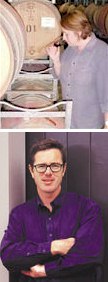
|
It was on October 2 1851 that Francis Treloar purchased his first piece of land in Watervale on which the historic Quelltaler winery stands today
On January 3, 1853 Treloar and his family moved to their new home in Watervale. The house was a simple hut like so many in which pioneer families began their farming lives. On June 15, 1854 Treloar planted his first patch of vines which he obtained as cuttings from a Mr Solly.
|


|
Established in 1983, Andrew Garrett Wines is regarded by consumers as a relaxed, unpretentious, successful brand that provides excellent value wines, entirely approachable and reliable
Andrew Garrett has always produced full-flavoured wines from fruit sourced mainly around the McLaren Vale and nearby Padthaway regions. Andrew Garrett Wines makes reds, whites and sparkling wines, including Australia's most popular Sparkling Burgundy, which is made from premium McLaren Vale Shiraz. The team at Andrew Garrett share many years collective experience in fashioning popular and memorable vintage releases, at some of the better winemaking estates around Australia.
|
|


